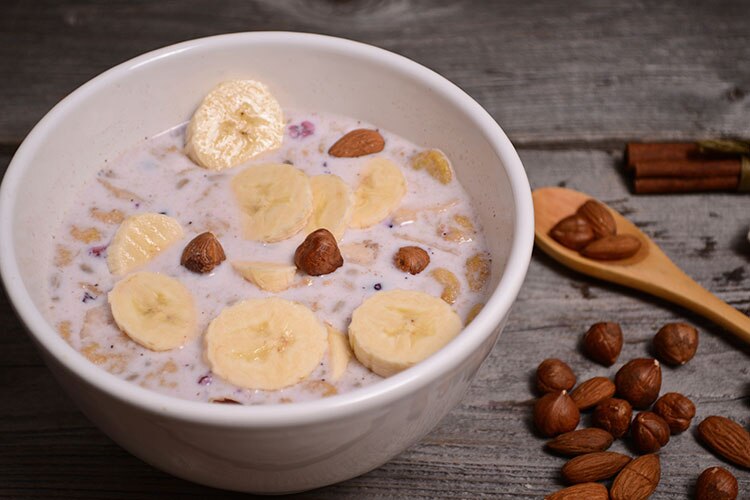Carbohydrates
A high-glycemic meal (one that significantly raises your blood sugar) has been proven to help you fall asleep faster – if taken four hours before bedtime.6 Carbs help increase tryptophan levels in your blood, which is why WebMD recommends considering carb-calcium combos for evening snacks, such as “a bowl of cereal and milk, yogurt and crackers, or bread and cheese.”7
Magnesium
Once asleep, one of the things that can wake us up is magnesium deficiency,8 and it has shown to help lessen insomnia symptoms in elderly people.9 To avoid that, work magnesium-rich foods into your diet, such as:10
- Nuts (i.e., almonds, cashews, peanuts)
- Boiled spinach
- Whole wheat bread, or shredded wheat cereal
- Soymilk
- Black beans
- Bananas
References
1 Source: Hartmann E. Effects of L-trytophan on sleepiness and on sleep. J Psychiatr Res 1982;17(2):107–13.
2 Source: United States Department of Agriculture. Nutrient Lists: Tryptophan(g). http://ndb.nal.usda.gov/ndb/nutrients/report?nutrient1=501&nutrient2=&nutrient3=&fg=&max=25&subset=0&offset=0&sort=c&totCount=5039&measureby=m (accessed March 5, 2015).
3 Source: Barbosa R et al. Tryptophan hydroxylase is modulated by L-type calcium channels in the rat pineal gland. Life Sci 2008;27(82):529–35.
4 Source: Medline Plus. Calcium. http://www.nlm.nih.gov/medlineplus/calcium.html (accessed March 5, 2015).
5 Source: Howatson G et al. Effect of tart cherry juice (Prunus cerasus) on melatonin levels and enhanced sleep quality. Eur J Nutr 2012;51(8):909–16.
6 Source: Afaghi A, O’Connor H and Chow CM. High-glycemic-index carbohydrate meals shorten sleep onset. Am J Clin Nutr 2007;85(2):426–30.
7 Source: WebMD. Sleep foods (slide 3). http://www.webmd.com/sleep-disorders/ss/slideshow-sleep-foods (accessed March 9, 2015). Click the pictures to advance through the slideshow.
8 Source: Watts DL. The nutritional relationships of magnesium. J Orthom Med 1988;3(4):197–201.
9 Source: Abbasi B et al. The effect of magnesium supplementation on primary insomnia in elderly: A double-blind placebo-controlled clinical trial. J Res Med Sci 2012;17(12):1161–9.
10 Source: National Institutes of Health. Magnesium: Fact sheet for health professionals. http://ods.od.nih.gov/factsheets/Magnesium-HealthProfessional/ (accessed March 6, 2015).
11 Source: The Natural Standard Research Collaboration via WebMD. Vitamin B6 (pyridoxine): Evidence. http://www.mayoclinic.org/drugs-supplements/vitamin-b6/evidence/hrb-20058788 (accessed March 9, 2015).
